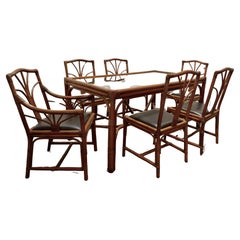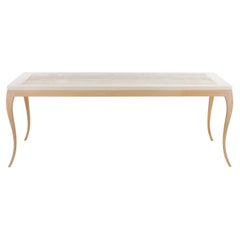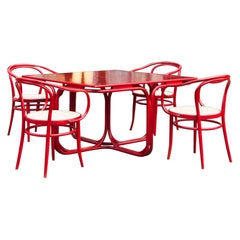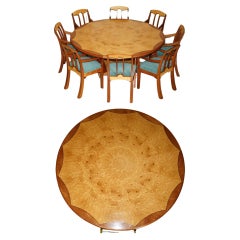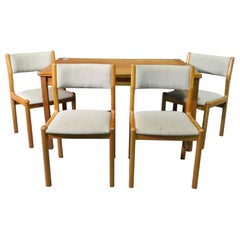Dining Room Sets
1950s Regency Revival Vintage Dining Room Sets
Bamboo
21st Century and Contemporary Portuguese Mid-Century Modern Dining Room Sets
Onyx, Quartz, Carrara Marble, Statuary Marble
1970s Czech Mid-Century Modern Vintage Dining Room Sets
Cane, Beech, Bentwood
20th Century English Art Deco Dining Room Sets
Walnut
1880s Mid-Century Modern Antique Dining Room Sets
Wood
1960s Mid-Century Modern Vintage Dining Room Sets
Teak
20th Century American Mid-Century Modern Dining Room Sets
Metal
1960s European Mid-Century Modern Vintage Dining Room Sets
Maple
2010s Dining Room Sets
Hardwood, Oak
Mid-20th Century Mid-Century Modern Dining Room Sets
Wood, Maple
2010s German Post-Modern Dining Room Sets
Oak
1990s Austrian Dining Room Sets
Upholstery, Wood
20th Century American Mid-Century Modern Dining Room Sets
1960s Danish Mid-Century Modern Vintage Dining Room Sets
Fabric, Teak
1960s Brazilian Mid-Century Modern Vintage Dining Room Sets
Wood
1970s Danish Mid-Century Modern Vintage Dining Room Sets
Wood
Mid-20th Century Finnish Scandinavian Modern Dining Room Sets
Birch
1970s German Mid-Century Modern Vintage Dining Room Sets
Beech
Mid-20th Century Danish Mid-Century Modern Dining Room Sets
Steel
1960s Danish Vintage Dining Room Sets
Rosewood
Early 19th Century Italian Baroque Antique Dining Room Sets
Wood, Giltwood
20th Century European Art Deco Dining Room Sets
Satinwood
1950s Danish Mid-Century Modern Vintage Dining Room Sets
Leather, Rosewood
1960s Belgian Brutalist Vintage Dining Room Sets
Oak
1920s Anglo-Indian Vintage Dining Room Sets
Pine
Mid-20th Century American Dining Room Sets
Aluminum
1930s Italian Mid-Century Modern Vintage Dining Room Sets
Wood
1960s American French Provincial Vintage Dining Room Sets
Upholstery, Wood, Paint
1880s Antique Dining Room Sets
Walnut
Early 20th Century Chinese Chinese Export Dining Room Sets
Mahogany
Late 20th Century Dining Room Sets
Wood
20th Century Dining Room Sets
Teak
20th Century English Mid-Century Modern Dining Room Sets
Leather, Oak
1950s Italian Mid-Century Modern Vintage Dining Room Sets
Iron
1970s American Organic Modern Vintage Dining Room Sets
Oak
1970s American Vintage Dining Room Sets
Aluminum
1960s Scandinavian Mid-Century Modern Vintage Dining Room Sets
Wood
Mid-20th Century Italian Mid-Century Modern Dining Room Sets
Steel
21st Century and Contemporary Portuguese Organic Modern Dining Room Sets
Brass
2010s Indian Louis XV Dining Room Sets
Metal
Mid-20th Century Louis XVI Dining Room Sets
Bronze
1950s Italian Mid-Century Modern Vintage Dining Room Sets
Glass, Wood
Mid-20th Century Italian Mid-Century Modern Dining Room Sets
Wood
Mid-20th Century Mid-Century Modern Dining Room Sets
Walnut
20th Century English Mid-Century Modern Dining Room Sets
Oak, Walnut
Mid-20th Century Danish Scandinavian Modern Dining Room Sets
Mahogany
Mid-20th Century American Mid-Century Modern Dining Room Sets
Metal
1960s Dutch Vintage Dining Room Sets
Leather, Wood
21st Century and Contemporary American Mid-Century Modern Dining Room Sets
Metal
2010s Mexican Modern Dining Room Sets
Wood
Mid-20th Century European Mid-Century Modern Dining Room Sets
Carrara Marble, Brass
20th Century Italian Other Dining Room Sets
Sapele Wood
1940s French Mid-Century Modern Vintage Dining Room Sets
Brass
1770s American Antique Dining Room Sets
Wood
1960s French Vintage Dining Room Sets
Wood
2010s American Modern Dining Room Sets
Steel
21st Century and Contemporary European Arts and Crafts Dining Room Sets
Steel
21st Century and Contemporary Belgian Modern Dining Room Sets
Aluminum
1950s Brazilian Mid-Century Modern Vintage Dining Room Sets
Concrete
1950s Brazilian Mid-Century Modern Vintage Dining Room Sets
Leather, Wood
Vintage, New and Antique Dining Room Sets
Introduce warmth and a welcoming atmosphere to meals in your home with an antique, new or vintage dining room set.
From the “less is more” approach of Scandinavian modern dining room sets, which are typically characterized by muted colors, clean lines and an emphasis on organic material, to rustic-chic farmhouse-style suppers to the pronounced geometric angles and dark woods of Art Deco, there are numerous directions to pursue when shopping for a dining room set.
No matter how much real estate you have to work with, the dining table will play an integral role in the elegant space where the whole family or your closest friends create new memories and mark momentous occasions. But be sure of your space before you buy and keep the rest of your decor scheme in mind: For a modest-sized room, you’ll want to consider the shape and style of your table to ensure that guests can easily move around and into the kitchen as needed. A set of widely loved Series 7 chairs, designed by mid-century modern architect Arne Jacobsen, paired with one of his streamlined dining room tables, for example, will surely have a small footprint in your dining area, while an antique mahogany dining room set originating during the Victorian era will bring sophistication and formality to your parties of 12 or more.
There are lots of dining room design ideas you can put into practice — get started today with a variety of antique, new or vintage dining room sets on 1stDibs.
